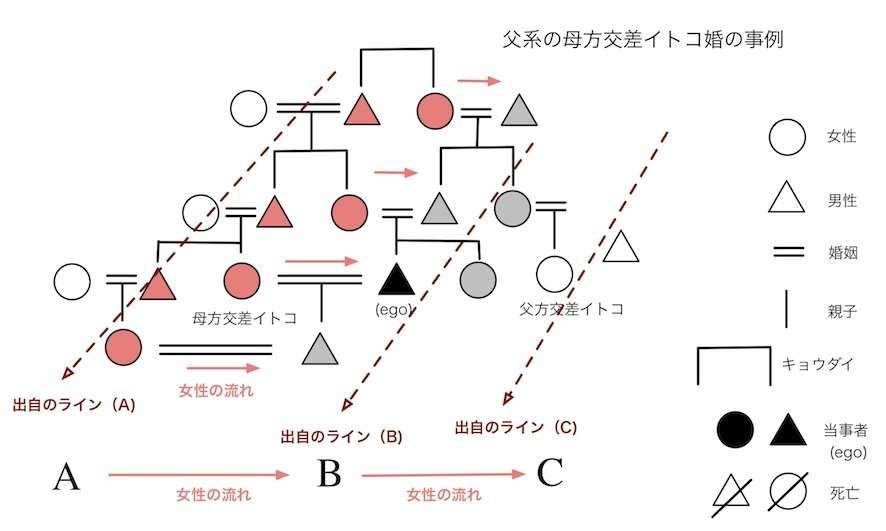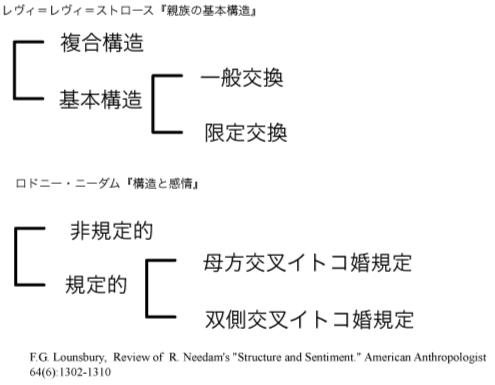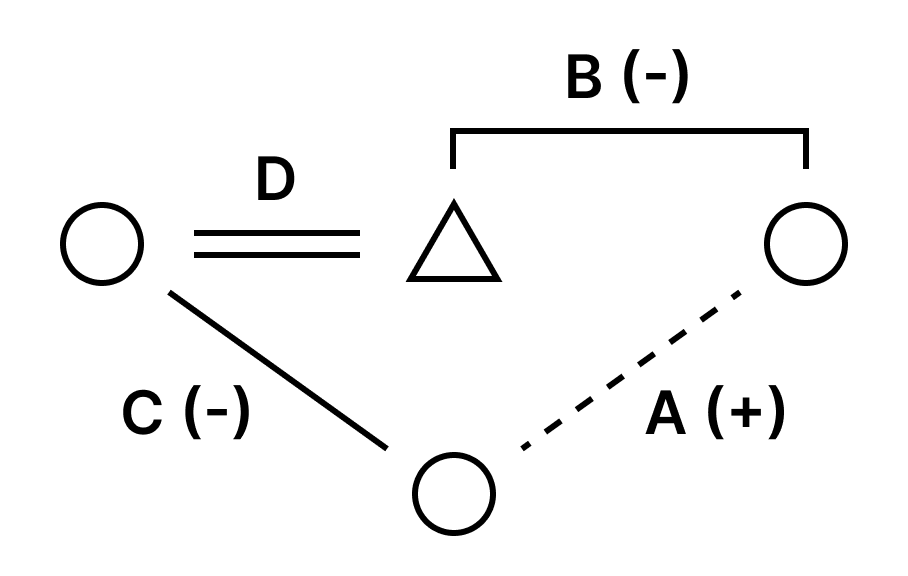Women
as Gifts

贈与としての女
Women
as Gifts

解説:池田光穂
●贈与としての「女性」:交叉イトコ婚
文化人類学において定義する、交差(こう さ)イトコ婚とは、両親の世代の ジェンダーがクロス(=交差)したイトコ、すなわち父親なら父方のオバの子供(=イトコ)あるいは、母親なら母方のオジの子供(=イトコ)と婚姻関係を結 ぶことで す。交差あるいは交叉イトコとは英語でCross Cousin(クロス・カズン)と呼びます。交叉と交差は、ともに「こうさ」と呼ませ、そして同じ意味です。つまり、当事者(読者のみなさん)が、女性な ら、父方のオバさんの息子と結婚することは、父方交差イトコ婚となり、母方のオジさんの息子と 結婚することは母方交差イトコ婚となります。ただし、出自(しゅつじ)や系譜(けいふ)関係——家督(例えばファミリーネームや名誉)や財産(土地や家 畜)が父方から息子へ継承される場合は父系(ふけい)と呼び、母から娘に伝わるとき母系(ぼけい)とよぶ——によって、当事者は男性か女性かであることを 認識しておかないと、想定される交差イトコ婚の相手のジェンダーについて混乱しますので、注意を要します。他方で、平行(へいこう)イトコ婚とは、両親の 世代の ジェンダーがパラレル(=平行)したイトコ、すなわち父親なら父方の伯父の子供(=イトコ)あるいは、母親なら母方のオバの子供(=イトコ)と婚姻関係を 結 ぶことで す。



A diagram illustrating Lévi-Strauss's theory of kinship. In such a case, one can infer that D is positive.
● クラリング
マ
リノフスキー「西太平洋の遠洋航海者」(1922)で著名になった、
人間の贈り物の習慣の様式のひとつである「互酬制」の事例として、しばしば「贈与論」(その代表がマルセル・モース)という議論のなかで使われるトロブリ
アンド諸島民のあいだの慣習行為とその概念である。
複数の特定のパートナーの間で、ソラヴァ=sourava(首飾り)とムワリ=muwali(腕輪)をやりとりする。
ソラヴァは時計回りに循環し、ムワリは反時計回りに循環する。
ソラヴァとムワリは同時的に交換されることはない。
ソラヴァとムワリは贈与と返礼という形をり、間を開けてやりとりする。
クラ交換では、パートナーから受けた贈与に対しそれを上回る価値の財宝で返礼するために、人々(=男性)の「気前の良さ」を競うことにな る。
"Kula, also known as the Kula exchange or Kula ring, is a ceremonial
exchange system conducted in the Milne Bay Province of Papua New
Guinea. The Kula ring was made famous by the father of modern
anthropology, Bronislaw Malinowski, who used this test case to argue
for the universality of rational decision making (even among
'natives'), and for the cultural nature of the object of their effort.
Malinowski's path-breaking work, Argonauts of the Western Pacific
(1922),[1] directly confronted the question, "why would men risk life
and limb to travel across huge expanses of dangerous ocean to give away
what appear to be worthless trinkets?" Malinowski carefully traced the
network of exchanges of bracelets and necklaces across the Trobriand
Islands, and established that they were part of a system of exchange
(the Kula ring), and that this exchange system was clearly linked to
political authority. Malinowski's study became the subject of debate
with the French anthropologist, Marcel Mauss, author of "The Gift"
("Essai sur le don," 1925).[2] Since then, the Kula ring has been
central to the continuing anthropological debate on the nature of gift
giving, and the existence of "gift economies.""(Source: Kula ring)
リンク
リンク
文献